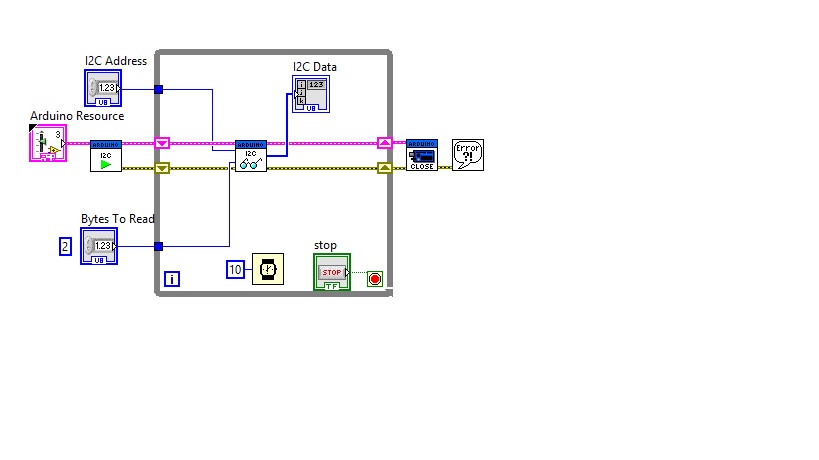- Subscribe to RSS Feed
- Mark Topic as New
- Mark Topic as Read
- Float this Topic for Current User
- Bookmark
- Subscribe
- Mute
- Printer Friendly Page
Problems with Arduino reading HMC6352 Compass on I2C
07-26-2013 07:16 PM
- Mark as New
- Bookmark
- Subscribe
- Mute
- Subscribe to RSS Feed
- Permalink
- Report to a Moderator
Hi, I`ve just started experimenting with LV on Arduino and run into difficulties reading the heading from an HMC6352 breakbout board.
I can read the device no problem using the following Arduino code:
=================
#include <Wire.h>
int HMC6352Address = 0x42;
// This is calculated in the setup() function
int slaveAddress;
int ledPin = 13;
boolean ledState = false;
byte headingData[2];
int i, headingValue;
void setup()
{
// Shift the device's documented slave address (0x42) 1 bit right
// This compensates for how the TWI library only wants the
// 7 most significant bits (with the high bit padded with 0)
slaveAddress = HMC6352Address >> 1; // This results in 0x21 as the address to pass to TWI
Serial.begin(9600);
pinMode(ledPin, OUTPUT); // Set the LED pin as output
Wire.begin();
}
void loop()
{
// Flash the LED on pin 13 just to show that something is happening
// Also serves as an indication that we're not "stuck" waiting for TWI data
ledState = !ledState;
if (ledState) {
digitalWrite(ledPin,HIGH);
}
else
{
digitalWrite(ledPin,LOW);
}
// Send a "A" command to the HMC6352
// This requests the current heading data
Wire.beginTransmission(slaveAddress);
Wire.send("A"); // The "Get Data" command
Wire.endTransmission();
delay(10); // The HMC6352 needs at least a 70us (microsecond) delay
// after this command. Using 10ms just makes it safe
// Read the 2 heading bytes, MSB first
// The resulting 16bit word is the compass heading in 10th's of a degree
// For example: a heading of 1345 would be 134.5 degrees
Wire.requestFrom(slaveAddress, 2); // Request the 2 byte heading (MSB comes first)
i = 0;
while(Wire.available() && i < 2)
{
headingData = Wire.receive();
i++;
}
headingValue = headingData[0]*256 + headingData[1]; // Put the MSB and LSB together
Serial.print("Current heading: ");
Serial.print(int (headingValue / 10)); // The whole number part of the heading
Serial.print(".");
Serial.print(int (headingValue % 10)); // The fractional part of the heading
Serial.println(" degrees");
delay(500);
}
===================
But I keep getting a 5003 error when trying to read it using the attached sketch, would appreciate and advice.
James
08-12-2013 04:16 PM
- Mark as New
- Bookmark
- Subscribe
- Mute
- Subscribe to RSS Feed
- Permalink
- Report to a Moderator
James,
It looks like the arduino code and the labview code are doing two very different things.
In the LabIVEW Code you pass a slave address of 42 (assuming that is decimal) but your arduino code uses a slave address of 0x21 (33 decimal).
You also are not sending any data. The 41 in the byte array wired to data is the index, not the value. Set the first element in the byte array to the value to send which looks like 'A' or 0x41 or 65 in decimal. Make sure you set the base correctly in LabVIEW.
Let us know if that helps.
-Sam K
LIFA Developer
12-06-2014 02:15 AM
- Mark as New
- Bookmark
- Subscribe
- Mute
- Subscribe to RSS Feed
- Permalink
- Report to a Moderator
Hello James,
I'm novice on labview.
I'm trying to read this type of compas HMC6352 by using labview but no success.
I'm using a wiring board (similar of arduino I think) and I can read the value by the wiring software but nothing by labview.
You will found in attach my diagram

Can you help me to be on a good way to solve my problem.
Thanks
Regards
Jeff
12-06-2014 01:47 PM
- Mark as New
- Bookmark
- Subscribe
- Mute
- Subscribe to RSS Feed
- Permalink
- Report to a Moderator
Only the Arduino Uno and Arduino Mega 2560 were supported by LIFA. Also, you should take a look at other example LIFA programs because you are missing the first critical VI (the initialization). Take a look at one of my libraries to see how to interface with I2C devices (the specifics can vary depending on the actual sensor. Here is a popular one that I created: https://decibel.ni.com/content/docs/DOC-34263
Also, for I2C stuff, I recommend that you use block diagram constants for the values you pass into the I2C VIs.
12-06-2014 08:18 PM
- Mark as New
- Bookmark
- Subscribe
- Mute
- Subscribe to RSS Feed
- Permalink
- Report to a Moderator
Thanks for your reply and your help Nathan.
I'm looking your librairies (seems to be that I need, cool!!!)
but I meet some difficulties to see your diagrams.
In fact, I've some errors appears, some icons have questions mark.
I digging on forums to solve that.
Still thank.
Regards
12-07-2014 08:24 AM
- Mark as New
- Bookmark
- Subscribe
- Mute
- Subscribe to RSS Feed
- Permalink
- Report to a Moderator
You have to unzip the zip file first. Otherwise it can't find any of the
subVIs that I created.
12-08-2014 05:11 PM
- Mark as New
- Bookmark
- Subscribe
- Mute
- Subscribe to RSS Feed
- Permalink
- Report to a Moderator
Ok thank, I understand better about the structure.
I have a question about my functions, I still have these question marks on icons, same after re-installed the software.
Have you an idea to solve that?
Regards
12-08-2014 08:46 PM
- Mark as New
- Bookmark
- Subscribe
- Mute
- Subscribe to RSS Feed
- Permalink
- Report to a Moderator
You are missing those VI's. You should try to re-install whatever module contains those VI's. Since that is not related to LIFA, you should ask those types of questions in the NI forums: http://forums.ni.com/
